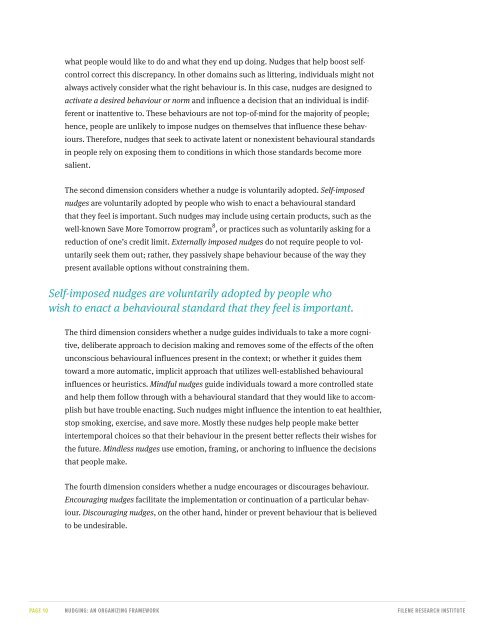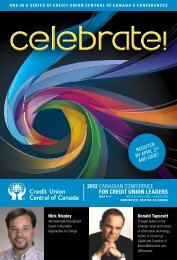A Practitioner’s Guide to Nudging
A Practitioner's Guide to Nudging - Credit Union Central of Canada
A Practitioner's Guide to Nudging - Credit Union Central of Canada
- No tags were found...
Create successful ePaper yourself
Turn your PDF publications into a flip-book with our unique Google optimized e-Paper software.
what people would like <strong>to</strong> do and what they end up doing. Nudges that help boost selfcontrol<br />
correct this discrepancy. In other domains such as littering, individuals might not<br />
always actively consider what the right behaviour is. In this case, nudges are designed <strong>to</strong><br />
activate a desired behaviour or norm and influence a decision that an individual is indifferent<br />
or inattentive <strong>to</strong>. These behaviours are not <strong>to</strong>p-of-mind for the majority of people;<br />
hence, people are unlikely <strong>to</strong> impose nudges on themselves that influence these behaviours.<br />
Therefore, nudges that seek <strong>to</strong> activate latent or nonexistent behavioural standards<br />
in people rely on exposing them <strong>to</strong> conditions in which those standards become more<br />
salient.<br />
The second dimension considers whether a nudge is voluntarily adopted. Self-imposed<br />
nudges are voluntarily adopted by people who wish <strong>to</strong> enact a behavioural standard<br />
that they feel is important. Such nudges may include using certain products, such as the<br />
well-known Save More Tomorrow program 8 , or practices such as voluntarily asking for a<br />
reduction of one’s credit limit. Externally imposed nudges do not require people <strong>to</strong> voluntarily<br />
seek them out; rather, they passively shape behaviour because of the way they<br />
present available options without constraining them.<br />
Self-imposed nudges are voluntarily adopted by people who<br />
wish <strong>to</strong> enact a behavioural standard that they feel is important.<br />
The third dimension considers whether a nudge guides individuals <strong>to</strong> take a more cognitive,<br />
deliberate approach <strong>to</strong> decision making and removes some of the effects of the often<br />
unconscious behavioural influences present in the context; or whether it guides them<br />
<strong>to</strong>ward a more au<strong>to</strong>matic, implicit approach that utilizes well-established behavioural<br />
influences or heuristics. Mindful nudges guide individuals <strong>to</strong>ward a more controlled state<br />
and help them follow through with a behavioural standard that they would like <strong>to</strong> accomplish<br />
but have trouble enacting. Such nudges might influence the intention <strong>to</strong> eat healthier,<br />
s<strong>to</strong>p smoking, exercise, and save more. Mostly these nudges help people make better<br />
intertemporal choices so that their behaviour in the present better reflects their wishes for<br />
the future. Mindless nudges use emotion, framing, or anchoring <strong>to</strong> influence the decisions<br />
that people make.<br />
The fourth dimension considers whether a nudge encourages or discourages behaviour.<br />
Encouraging nudges facilitate the implementation or continuation of a particular behaviour.<br />
Discouraging nudges, on the other hand, hinder or prevent behaviour that is believed<br />
<strong>to</strong> be undesirable.<br />
PAGE 10 NUDGING: AN ORGANIZING FRAMEWORK FILENE RESEARCH INSTITUTE



